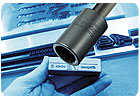
Snap-On Inc. uses double-milled stamps to mark its wrench sockets to ensure clean marking and long stamp life.
Over the past 20 years, many manufacturers have employed the electrical discharge machining (EDM) process when producing steel marking stamps in an effort to produce their stamps faster and at a lower cost. However, the result has often been a reduction in stamp tool life and loss of mark readability-in part, due to the fact that the intense local heating required by the EDM process metallurgically changes the surface of the stamp characters as well as the subsurface to a depth of 0.005 inch.
In contrast, tests have shown that engraved stamps that are double-pass milled using tools operating at up to 50,000 rpm will typically last twice as long, and in some instances up to eight times as long as EDM stamps.
It was with this long-term advantage in mind that tool manufacturer Snap-On Inc. (Kenosha, WI) recently began using milled stamps from Columbia Marking Tools (Chesterfield, MI) on a series of wrench sockets that it produces for industrial use.
Because manufacturers of hand tools produce millions of the same kind of component, they are very sensitive to quality and readability of their marks. Not only is their marking functionally important, it also presents a look that conveys the idea of quality and precision. Snap-On elected to go with the Columbia Marking Tool stamps after conducting a series of tests in which the stamps were shown to be both more effective and longer lasting.
When producing the Snap-On stamps, Columbia design engineers use 3D Solid Works software in conjunction with CAD data provided by Snap-On to ensure the stamps are to spec. Columbia also adapted the stamps to work with the unique quick-change tooling that Snap-On uses with its roll-marking machines. Finally, Columbia Marking Tools coats each engraved stamp with a proprietary ACC Auto Clean electroless nickel coating, which prevents rust and repels dirt.
This latter feature plays a key role in maximizing the lifespan of Columbia’s various marking products. Because steel marking stamps are considered secondary operation tools, it’s not uncommon for manufacturers to use a single stamp for as long as 6 months before replacing it. Combined with the increased use of environmentally friendly water-soluble lubricants and release agents, this can result in compacted dirt in the character grooves. This, in turn, compromises mark clarity. By coating its stamps so that they resist this type of degradation, Columbia ensures that its customers will get the most out of their marking products.
For more on part marking, visitwww.columbiamt.comor call 800-469-MARK.